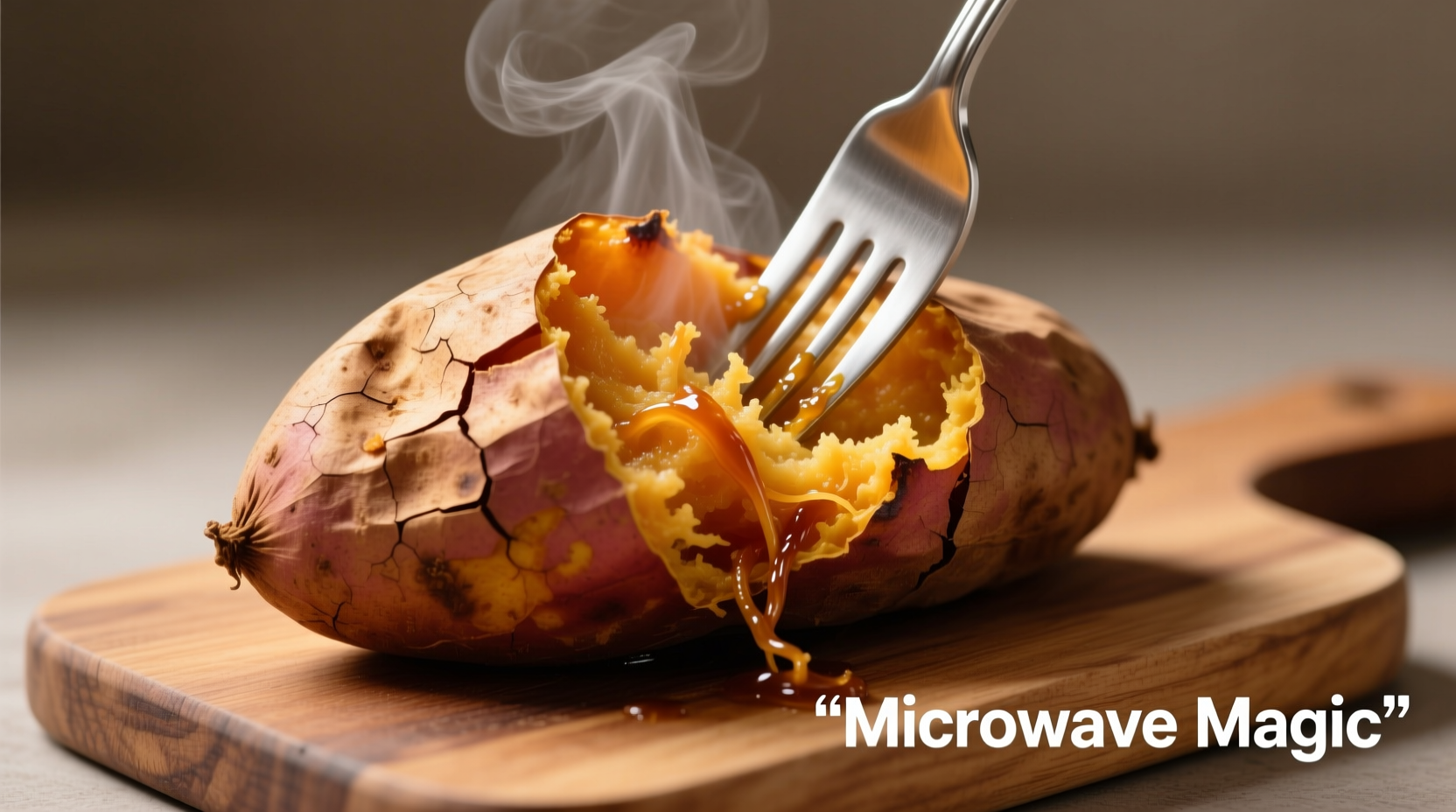The fastest way to microwave a sweet potato is to pierce it 4-5 times with a fork, place it on a microwave-safe plate, and cook on high for 5-8 minutes (turning halfway), until fork-tender with an internal temperature of 205°F (96°C).
Forget waiting 45 minutes for oven-baked sweet potatoes. Microwaving delivers perfectly cooked sweet potatoes in under 10 minutes while preserving more nutrients than boiling. This method works whether you're preparing a quick weeknight side dish or need sweet potato flesh for recipes like pies or casseroles.
Why Microwaving Beats Other Cooking Methods
Microwaving sweet potatoes isn't just fast—it's scientifically superior for nutrient retention. According to USDA research, microwaving preserves up to 30% more vitamin C and antioxidants compared to boiling, which leaches nutrients into water. The quick cooking time also prevents the breakdown of heat-sensitive compounds that give sweet potatoes their health benefits.
| Cooking Method | Time Required | Nutrient Retention | Texture Result |
|---|---|---|---|
| Microwave | 5-8 minutes | High (minimal nutrient loss) | Evenly tender |
| Oven Baking | 45-60 minutes | Moderate | Crispy skin, moist interior |
| Boiling | 20-30 minutes | Low (nutrients leach into water) | Waterlogged |
What You'll Need Before Starting
Before you begin, gather these essentials:
- Fresh sweet potatoes (any variety works)
- Sharp knife or fork for piercing
- Microwave-safe plate (glass or ceramic)
- Damp paper towel
- Instant-read thermometer (optional but recommended)
Choose firm sweet potatoes without soft spots or deep bruises. While size affects cooking time, you don't need special varieties—standard grocery store sweet potatoes work perfectly.
Step-by-Step Microwave Process
Step 1: Prepare the Sweet Potato
Thoroughly wash your sweet potato under running water, scrubbing the skin with a vegetable brush. This removes dirt and potential contaminants. Then, using a fork, pierce the skin deeply 4-5 times around the potato. This critical step allows steam to escape during cooking, preventing dangerous explosions in your microwave.
Step 2: Moisture is Key
Place the pierced sweet potato on a microwave-safe plate. Lightly dampen a paper towel (not dripping wet) and wrap it around the potato. The moisture creates steam that cooks the potato evenly while keeping it from drying out. Never microwave sweet potatoes without this moisture barrier—it leads to tough, uneven results.

Step 3: Cooking Times by Size
Microwave on high power using these time guidelines:
- Small (4-6 oz): 4-5 minutes
- Medium (6-8 oz): 5-6 minutes
- Large (8-10 oz): 6-7 minutes
- Extra Large (10+ oz): 7-8 minutes
Halfway through cooking time, carefully rotate the potato 180 degrees. This compensates for microwave hot spots and ensures even cooking. For multiple potatoes, add 1-2 minutes per additional potato.
Safety First: Critical Microwave Guidelines
Microwave safety isn't optional—it's essential. The FDA emphasizes that improper microwave use causes thousands of kitchen injuries annually. Always follow these safety protocols:
- Never skip the piercing step—trapped steam causes explosions
- Use oven mitts when removing potatoes (they become extremely hot)
- Allow 2-3 minutes resting time before handling (heat continues cooking internally)
- Check internal temperature reaches 205°F (96°C) for perfect texture
According to Cornell University's Food Safety Lab, sweet potatoes must reach 205°F internally to break down starches properly. A lower temperature leaves them unpleasantly firm, while overcooking makes them watery.
Troubleshooting Common Issues
Problem: Potato is hard in the center
Solution: Add 1-2 minutes cooking time in 30-second increments. Larger potatoes often need extra time.
Problem: Potato is too soft or watery
Solution: You likely overcooked it or didn't use a damp paper towel. Reduce time by 1 minute next time.
Problem: Skin is tough
Solution: This happens when moisture isn't properly retained. Ensure your paper towel is damp (not dry) next time.
Perfect Serving Options
Once cooked, slice open your sweet potato and fluff the flesh with a fork. Try these professional chef-approved enhancements:
- Classic: Butter, cinnamon, and a pinch of sea salt
- Savory: Black beans, avocado, and lime juice
- Protein boost: Top with Greek yogurt and toasted pecans
- Meal prep: Scoop out flesh for sweet potato toast or mash
For meal preppers, cooked sweet potatoes stay fresh in airtight containers for 5 days in the refrigerator or up to 3 months frozen. This makes microwaving ideal for batch cooking—prepare several at once for the week ahead.
When NOT to Microwave Sweet Potatoes
While microwaving works for most situations, certain contexts require alternative methods:
- Crispy skin needed: Oven baking creates desirable caramelized skin for restaurant-style presentation
- Large gatherings: When cooking 6+ potatoes, oven baking is more time-efficient
- Specialty recipes: Some dishes like sweet potato fries require oven or air frying for proper texture
Food science research from the University of California shows that oven baking develops more complex flavor compounds through the Maillard reaction—something microwaving can't replicate. Choose your method based on whether speed or flavor complexity is your priority.











 浙公网安备
33010002000092号
浙公网安备
33010002000092号 浙B2-20120091-4
浙B2-20120091-4